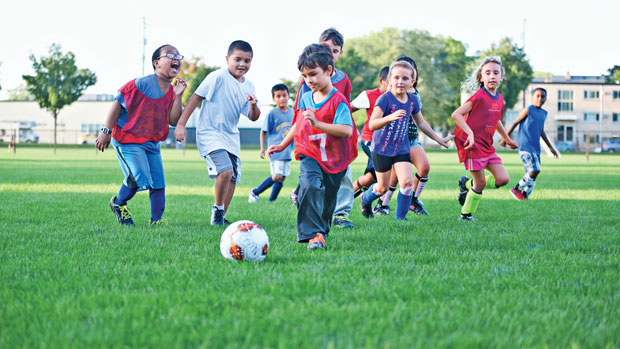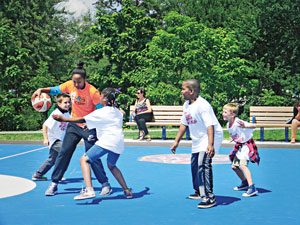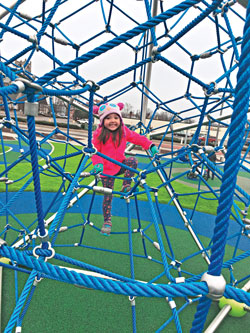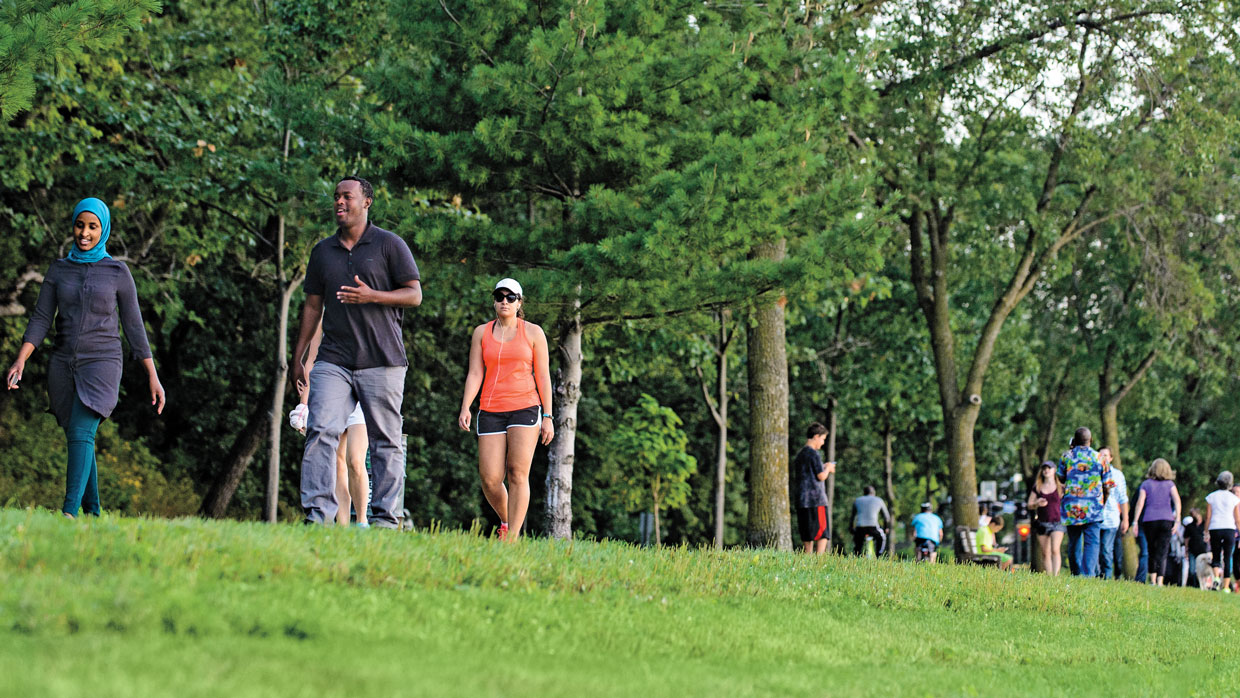When Nayab Saiyed moved to Plano, Texas, from Vermont in 2015, he didn’t know a single person in the state. While the 38-year-old software architect and his wife were scouting the area for prospective houses and suitable schools, he found himself staring at something that gave him flashbacks to his childhood in India: a bowler and a batsman battling in between the wickets.
This familiar scene was being played on well-manicured regulation cricket fields at the Russell Creek Park, the only public park in the United States with seven fields dedicated to the sport. Amazingly, Nayab, a lifelong fan, just stumbled upon it. “We saw these people playing cricket, and I was literally in awe,” he recalls. “My god, for a guy like me, this is heaven.”
From that point on, he didn’t care where he and his family lived, as long as his house was close to that park. It’s been just over a year now and he spends nearly every weekend playing cricket with a group of guys he met who were in his same situation: expats from various Southeast Asian countries looking for something to remind them of home.
“It’s like brotherly. We go for dinner or lunch after every game. We have a tradition to go to a restaurant as a group,” Nayab says. “We celebrate victories and good performances. We encourage people.”
For Nayab and his friends, this kind of activity is not only a game-changer in their personal lives, it is also good for community well-being. A recent collaborative study using data collected from sources such as the
Gallup-Healthways Well-Being Index and the
Trust for Public Land finds that maintained public parks and green spaces in U.S. urban areas have myriad benefits to the economy, the environment and for residents’ health and happiness.
Why green is good
Most of our history as human beings has been spent outdoors, so keeping ourselves cooped up inside buildings and houses seems almost unnatural. Because of growth, densely populated metros have gobbled up most of the green spaces. Studies reveal negative consequences when we don’t have access to parks, trees, nature trails and waterways. This can pave the way for poor health, poverty and even crime.
Research scientists Viniece Jennings, Ph.D., with the United States Forest Service and Lincoln R. Larson, Ph.D., an assistant professor in the Department of Parks, Recreation, and Tourism Management at North Carolina State University, are working hard to prove why public parks and green spaces are good for our individual mental and physical health, as well as the well-being of the surrounding communities.

“We are just now—in the past decade—really starting to understand what connection to green space does for our physical and psychological well-being,” Lincoln says. “We need to take bigger steps and understand the role these spaces play in satisfaction and social cohesion, fostering social capital and getting to know your neighbors in these safe spaces. We need to think about well-being more holistically and parks and green space, particularly in urban areas, being at the center of that find what that sustainable and healthy future looks like.”
Without these green spaces, we can start to develop what journalist, author and nature advocate Richard Louv coins as a nature-deficit disorder, or a loss of connection to the outdoor world, especially in young people. While it is not a medical diagnosis, it does raise the question of what can happen when we isolate ourselves from the natural world with emerging technology and modern housing that keeps us indoors.
“Space plays a powerful role in our outlook and health,” Viniece says. “It’s not just a combo of what we eat or our genetics, but it is also where we live, where we work and where we play. The options that are in our environment can help us have active lifestyles and positive perceptions of life.”
In Lincoln and Viniece’s multiple joint studies, they find that exercising outdoors compared with inside is strongly associated with positive mental health. Without places for people to stay active, sedentary lifestyles increase with negative impacts on their cardiovascular health. Socially, neighborhoods with more parks report increased interaction among residents, which adds to stronger bonds and life satisfaction.
“Parks can really help community well-being,” Viniece says. “And that is an important part of livable cities and can influence where people plan to move.”
“When you take the green out of the cities, you are also losing these places for social interaction and fostering that kind of engagement that is an essential aspect of humanity,” Lincoln adds. “If you don’t have these spaces, it is hard to replicate that in other settings.”
Lincoln also points out that local parks and greenways have shown to be great economic centers and cultural hubs with the added benefit of environmental sustainability. An example is his recent assessment of
The 606 trail in Chicago, which is an old train line converted into a 3-mile linear bike and hike trail. Since opening nearly two years ago, Lincoln says their research shows that property values have increased and crime rates decreased in the neighborhoods closest to the trail.
Trails and greenways “create corridors of connectivity between neighborhoods, home and work, and facilitate sustainable transportation that eases the environmental burden caused by exhaust and greenhouse gases,” Lincoln says. “It also means a happier population because they are enjoying the commute.”
City of parks
The state of Minnesota may be the land of 10,000 lakes, but in Minneapolis, the park system is the crown jewel, at least according to the Trust for Public Land, which rated the city’s park system the best in the country multiple years in a row. Jayne Miller, Minneapolis Park and Recreation Board superintendent since 2010, says that the park system has a long and rich history. Created by the legislature in 1883 and ratified by the voters, the parks board has been operating independently from the city and managing the park system for 134 years.
“We are a city actually built around the park system,” Jayne says. Now 95 percent of the population has access to a park or green space within a 10-minute walk and can travel throughout the city’s trail system without seeing a car. “When people are asked why they live in Minneapolis, the first thing out of their mouths is the parks,” Jayne says. “Because of the park system, we have that quality of life.”

Tammy Severe, a 55-year-old project manager, agrees. She says people don’t have to look very far to find a park or a trail. She keeps tennis shoes, a lawn chair and a blanket in her car for when she gets the urge to decompress for a spell.
“There’s the beauty of nature, but a lot of these parks have social activities: fairs, festivals, family reunions,” she says. “It’s definitely a core part of Minneapolis.”
Tammy has connected with several different groups through Meetup.com, including the Outdoor and Snow Lovers group, that meet weekly to walk the area lakes, hike through historic parts of the city or stroll through the arboretum after work.
“Everyone is there for a common reason and you have all walks of life,” she says. “It’s a built-in social group.” Parks also help residents maintain active lifestyles, essential for well-being. Runner’s World named Minneapolis the seventh “Best Running City” and the American College of Sports Medicine American Fitness Index ranked it second “Fittest City.”
“I have worked in a number of communities that have strong park systems and a strong ethos around parks and recreation, but nothing greater than the city of Minneapolis,” Jayne says. “People get it, they value it and they use it year-round. They know what it does to contribute to their high quality of life here.”
And they back it up with their tax dollars by approving funding campaigns, raising awareness through citizen advisory committees and convincing the city council to earmark extra funds for park maintenance and restoration. Over the next 20 years, that will amount to nearly $250 million in additional funding. “We don’t make decisions about investments without working it through with the communities and the neighborhoods,” Jayne says.
With the residents fully involved, Jayne and the rest of the board have the freedom to maintain a fully functional park system throughout the whole city, including areas where green space is more difficult to access.
“Having these places to go that are easily accessible to get out and be active, be with friends, be social, whatever you do for yourself that gives you that strength as to who you are as an individual also strengthens the community,” Jayne says. “In urban areas where socioeconomic divisions are greater, ensuring that everyone has access to that space, to get on a trail and walk or take a bike, sit on a park bench or have a picnic, it is fundamental to the health and well-being of people.”
A case for green space
Not all large cities in the United States have the luxuries afforded to places like Minneapolis or an independently governed parks board or Plano with an emerging tax base and growing economy. Indianapolis, Indiana, ranks near the bottom of the Trust for Public Land’s 2016 list at 95 out of the 100 largest cities in the U.S. While Indianapolis has more than 11,000 acres of parkland compared to the 5,064 acres in Minneapolis, that only makes up 5.1 percent of the city’s area and only 32 percent of the population can access it.

According to the trust, Indianapolis spends roughly $26 per person on its parks. If you compare that number to Minneapolis, which spends $223, or Plano, which spends about $120, there are not a lot of resources to work with. Indianapolis is part of a city-county government, with resources divided among multiple towns and municipalities. Finding money is difficult, but
Indy Parks Director Linda Broadfoot doesn’t dispute the need for a healthy and vibrant parks system to help spur the local economy and maintain positive health and well-being within the city.
“We are not focused on the number; we are focused on how we serve the community,” she says, adding that Indy Parks manages more than 125 playgrounds, 135 miles of trails, 155 sports fields and 210 parks as well as feeding more than 400,000 hungry kids annually. Part of her challenge is getting people to understand the value of parks and why green spaces are good not only for the health and happiness of the individual but also for the city’s economic development and quality of life.
“The lesson I had to learn is that it is not obvious to everyone,” Linda explains. “We can show that [being near a park] is good for property values. There is just something inherently good about being next to these places.”
Parks are about planning
It’s clear that the people who work and run city parks and recreation agencies have a common dedication to improving the quality of life in their respective communities.
Because of the urban planning that took place in the 1980s, when Plano was a small but burgeoning bedroom community, most of the neighborhoods were built around schools with a park in the center within every square mile. It took a lot of different departments and groups, including the public working together, but it was important to the city to maximize the open space and make sure kids are next to schools and parks.
Renee Jordan,
chief park planner for Plano, says that neighborhood parks are designed to be within walking distance. “These spaces are important for people who live in intense urban and suburban cities,” she says. “They need to feel renewed and refreshed.”
Renee also says it’s important for planners to anticipate the changing needs of the population. For example, in the 1970s and ‘80s when Plano’s master plan was being developed, no one anticipated a need for cricket fields. She says Plano is adapting to those needs to make sure there is a little something for everyone, including equipment that accommodates children with special needs.
Catering to a changing demographic and interests can mean installing more soccer and cricket fields, or adding courts for different sports like
pickleball, popular among retirees, or designated skate parks, popular among youths.
Urban parks and trails may be costly upfront, but according to a recent review released by the American Journal of Health Promotion, it is the most cost-effective way to increase physical activity and health among dense populations.
For Nayab, it’s more than just exercise—he also found happiness. Just one year after starting his cricket club, Nayab and his new friends are now champions of the Dallas Cricket League, and it all started with a neighborhood public park.
“All the guys in my Meetup group were just like me, we didn’t know how to get started at first,” he says. “We found a home—similar backgrounds and experiences and we get along well—all of Southeast Asia is represented in our group. It has been a great experience.”
Chris Libby is the Section Editor for Live Happy magazine. His last feature story was Find Your Funny Bone.
(Visited 1,857 times, 1 visits today)

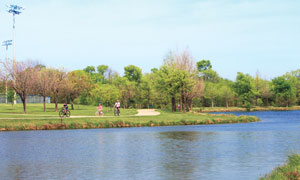 “We are just now—in the past decade—really starting to understand what connection to green space does for our physical and psychological well-being,” Lincoln says. “We need to take bigger steps and understand the role these spaces play in satisfaction and social cohesion, fostering social capital and getting to know your neighbors in these safe spaces. We need to think about well-being more holistically and parks and green space, particularly in urban areas, being at the center of that find what that sustainable and healthy future looks like.”
“We are just now—in the past decade—really starting to understand what connection to green space does for our physical and psychological well-being,” Lincoln says. “We need to take bigger steps and understand the role these spaces play in satisfaction and social cohesion, fostering social capital and getting to know your neighbors in these safe spaces. We need to think about well-being more holistically and parks and green space, particularly in urban areas, being at the center of that find what that sustainable and healthy future looks like.”